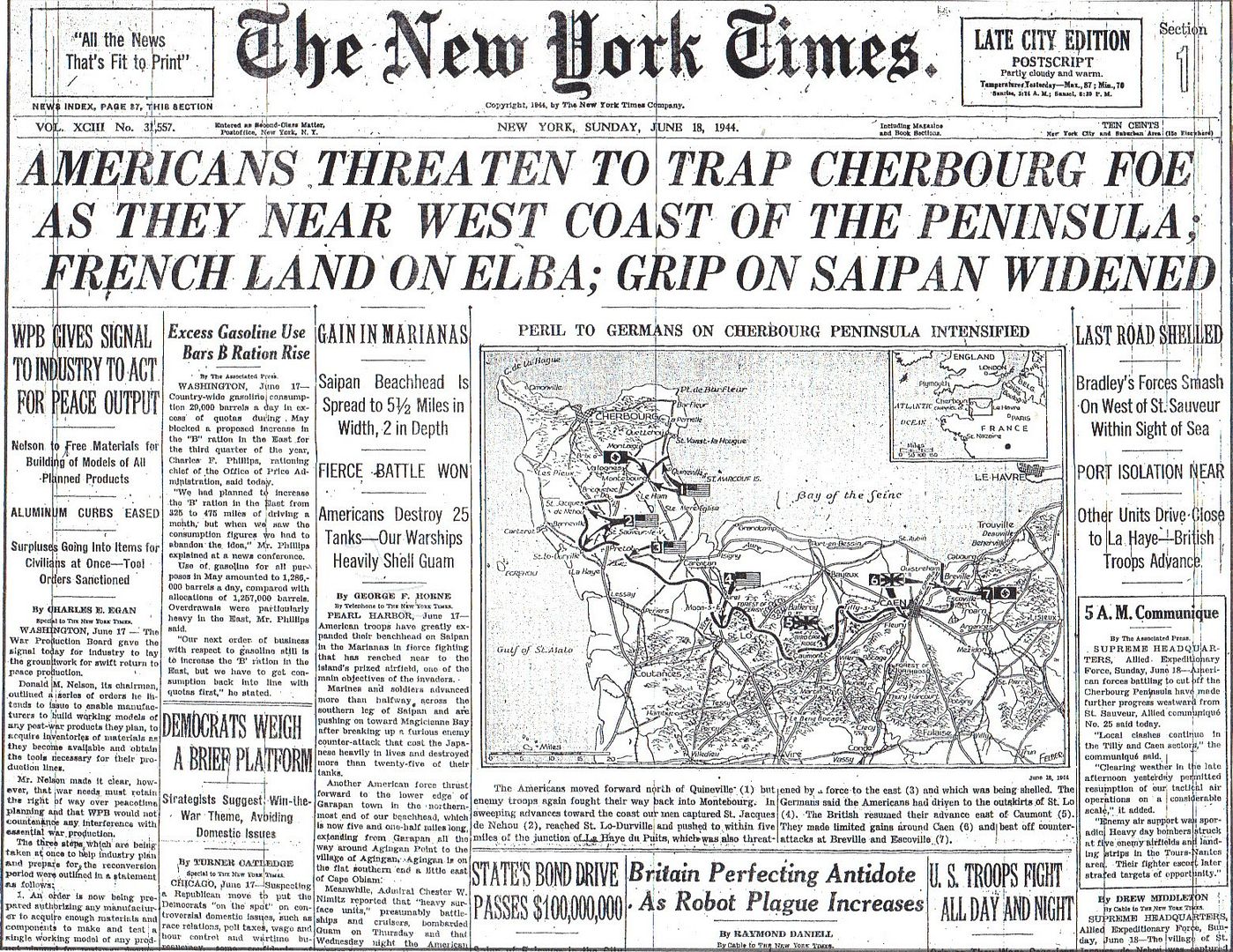
Posted on 06/18/2014 5:12:19 AM PDT by Homer_J_Simpson

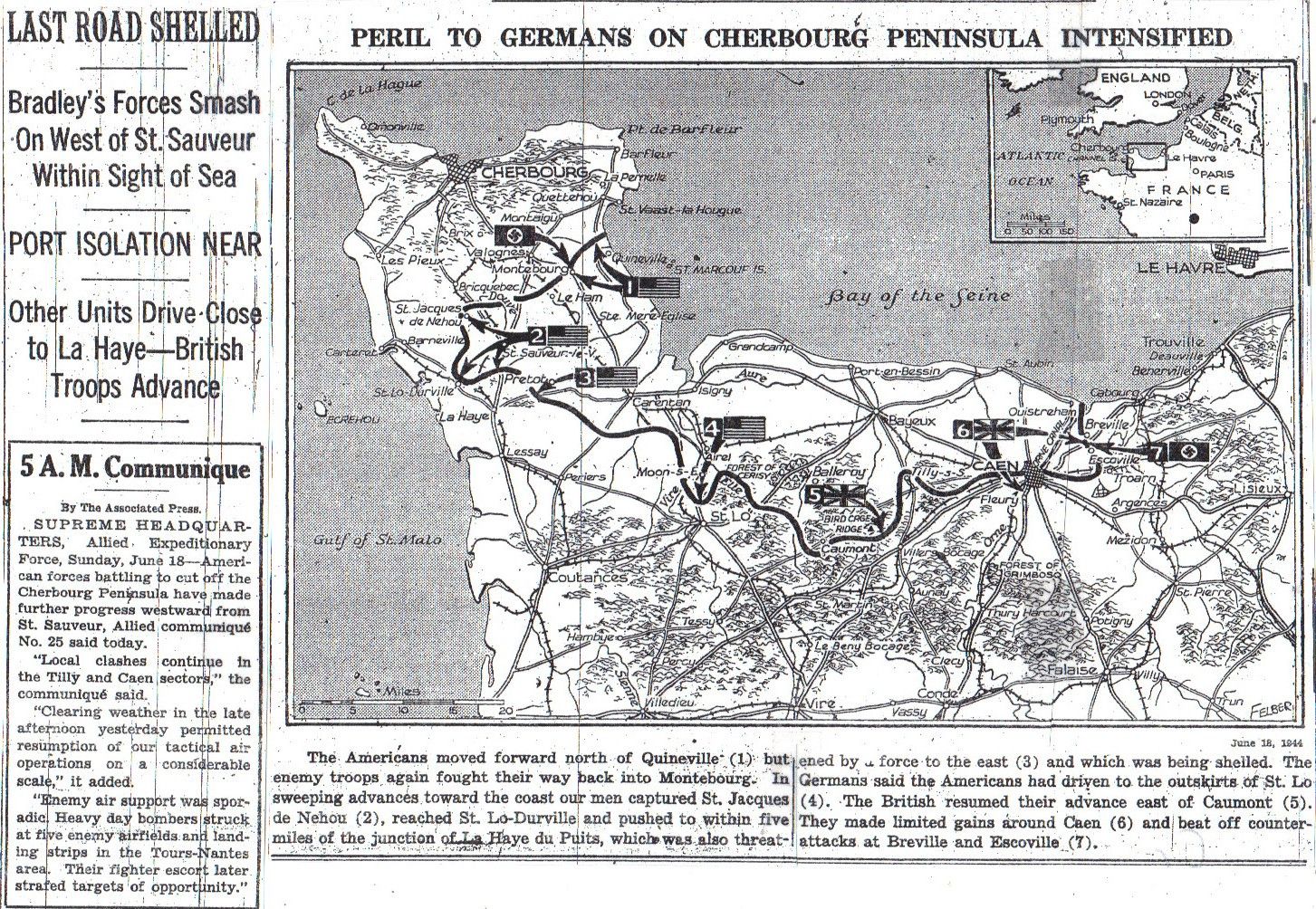
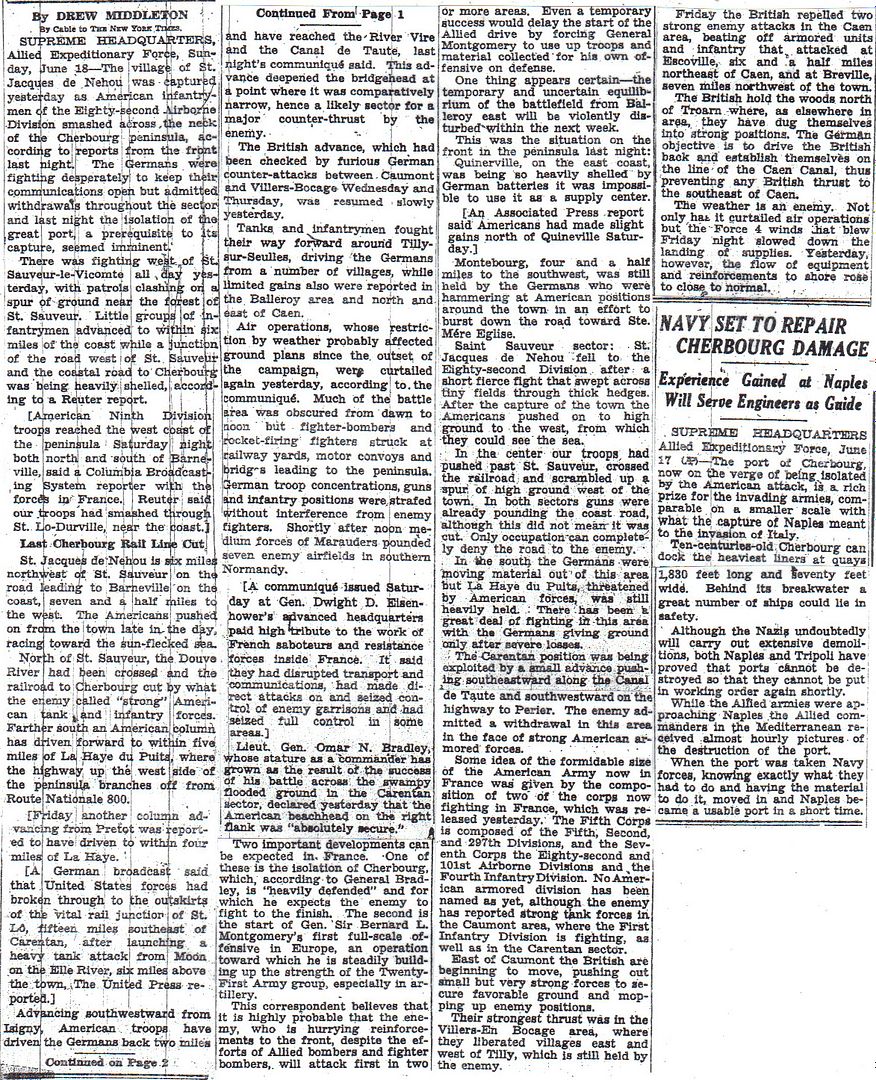
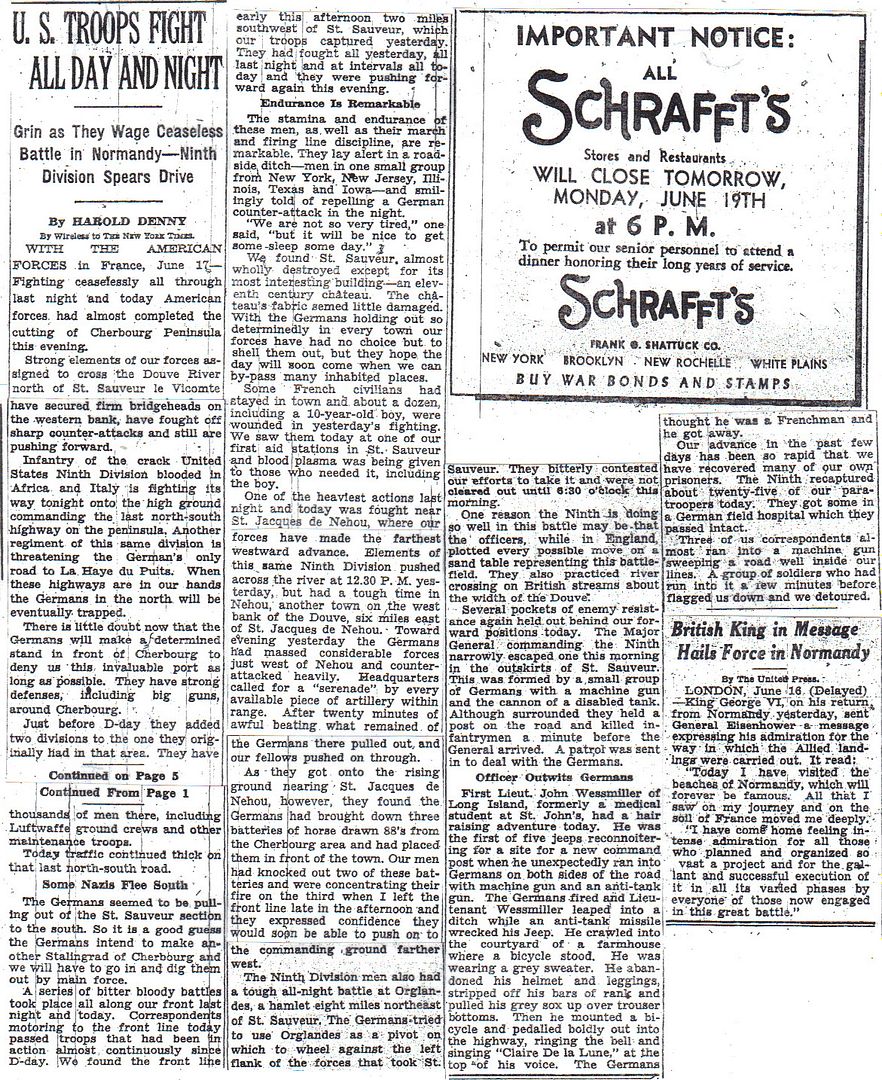
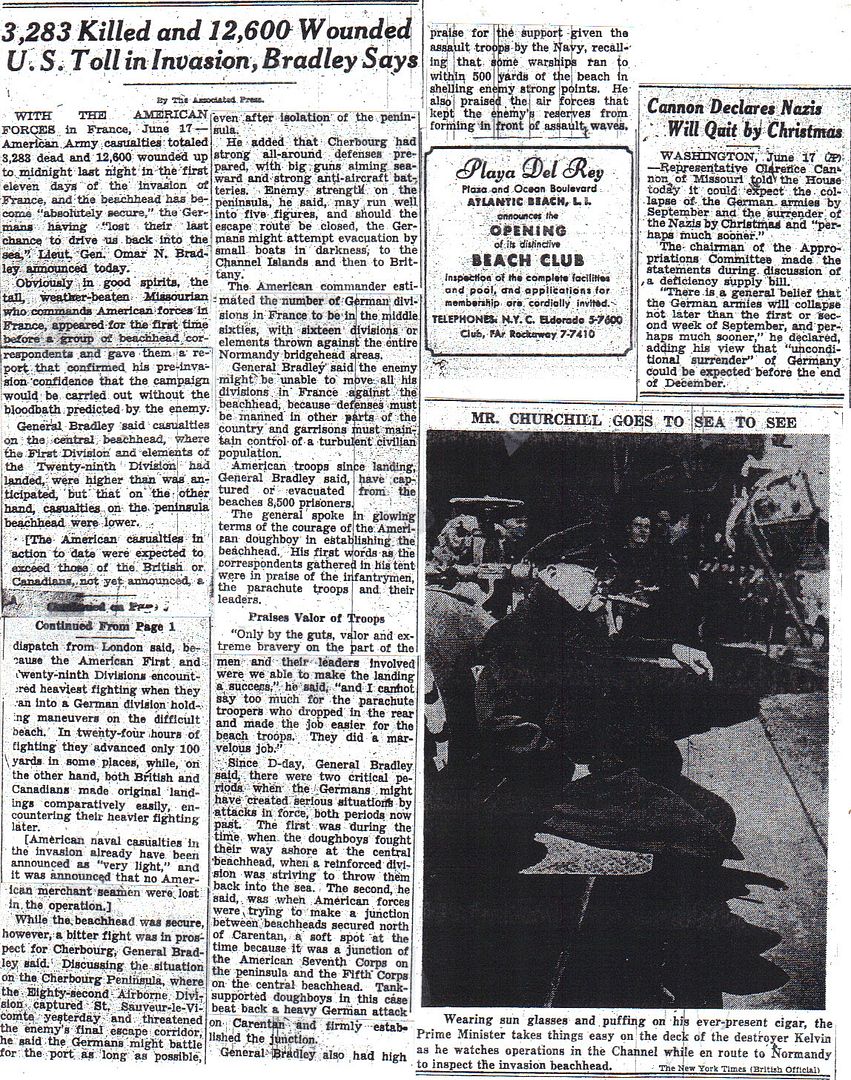

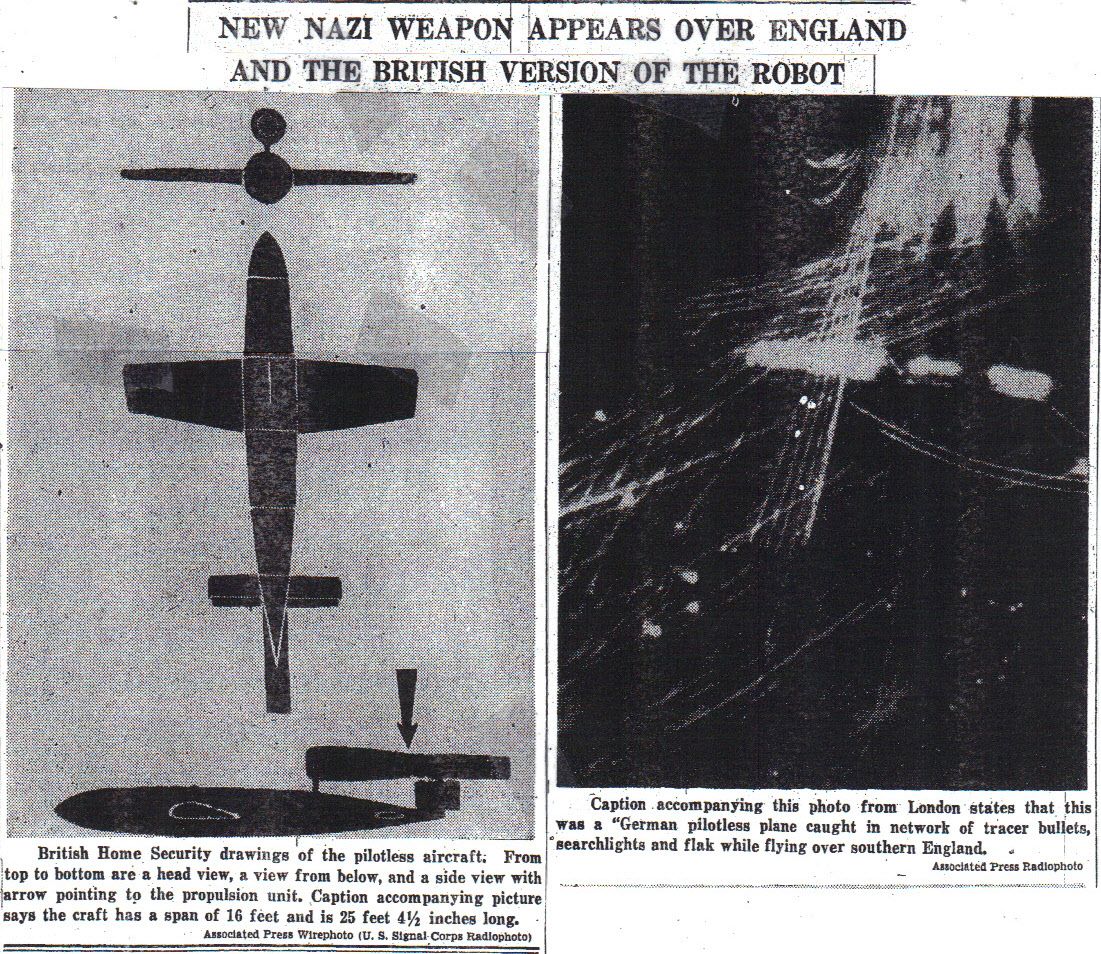

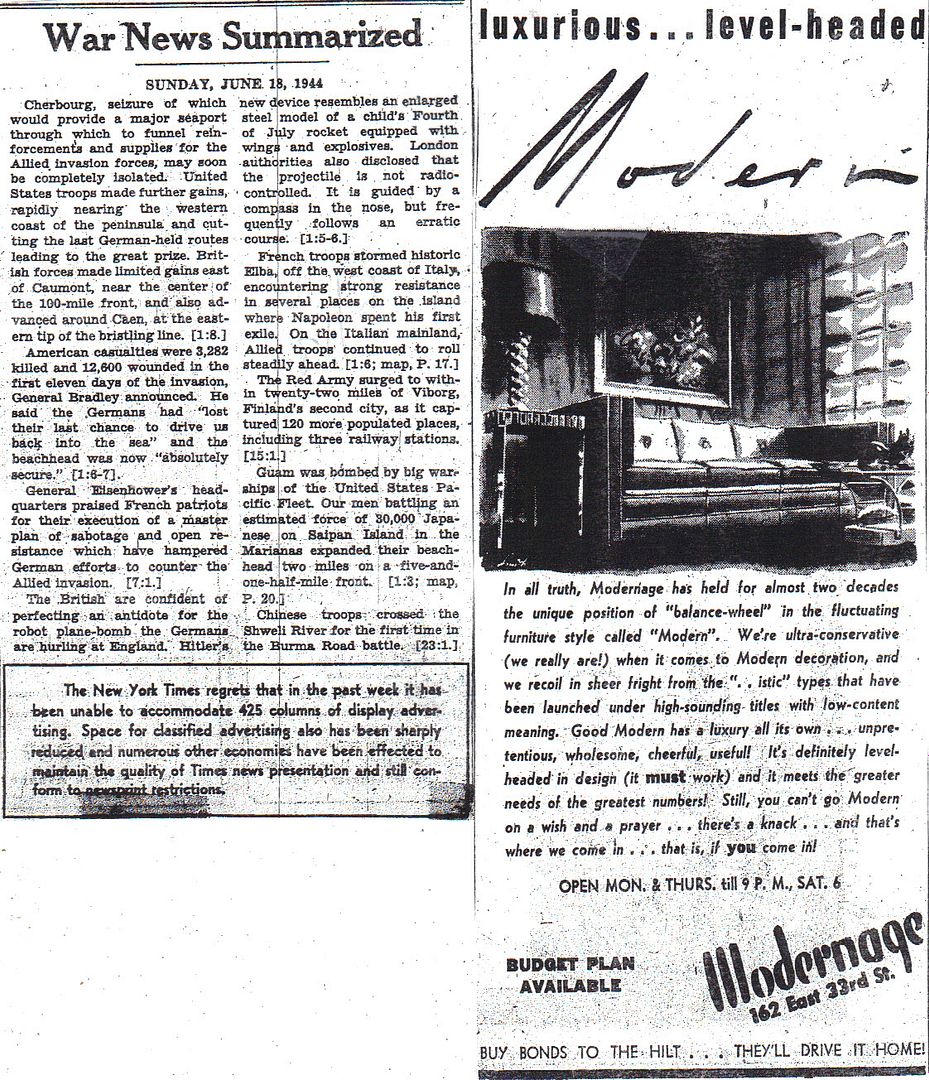
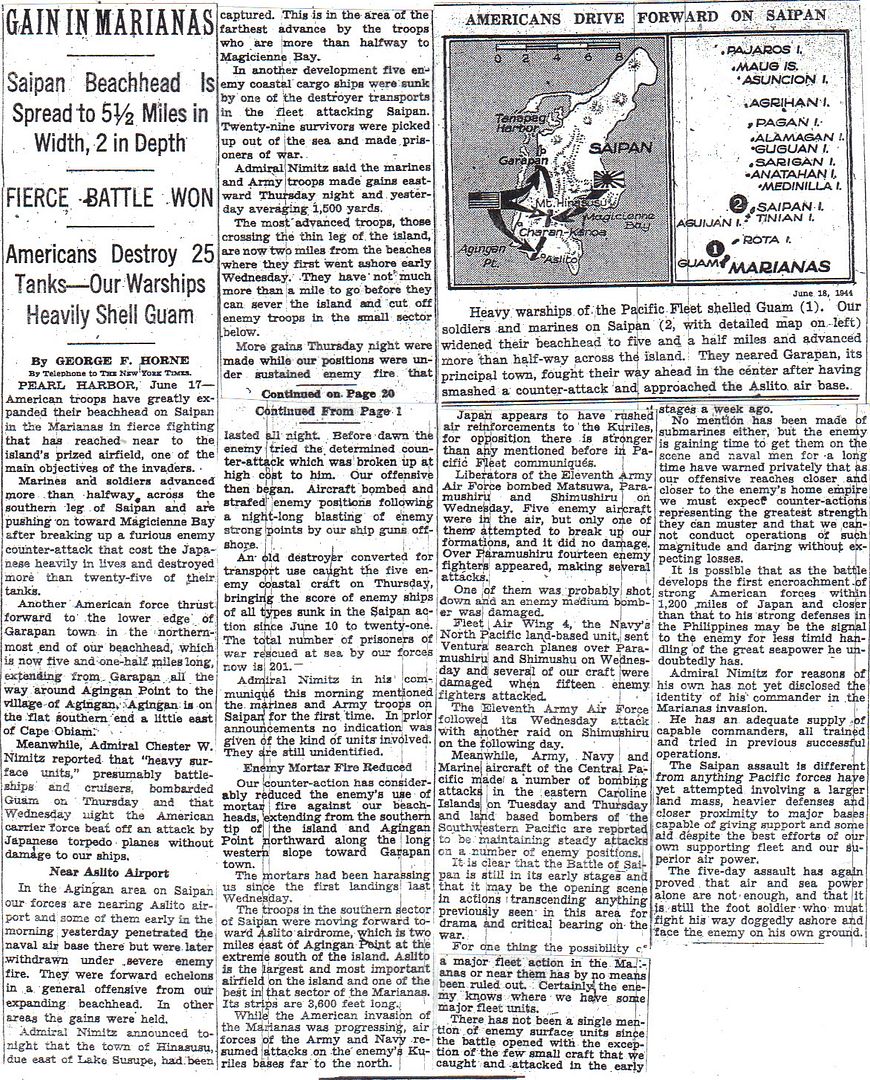

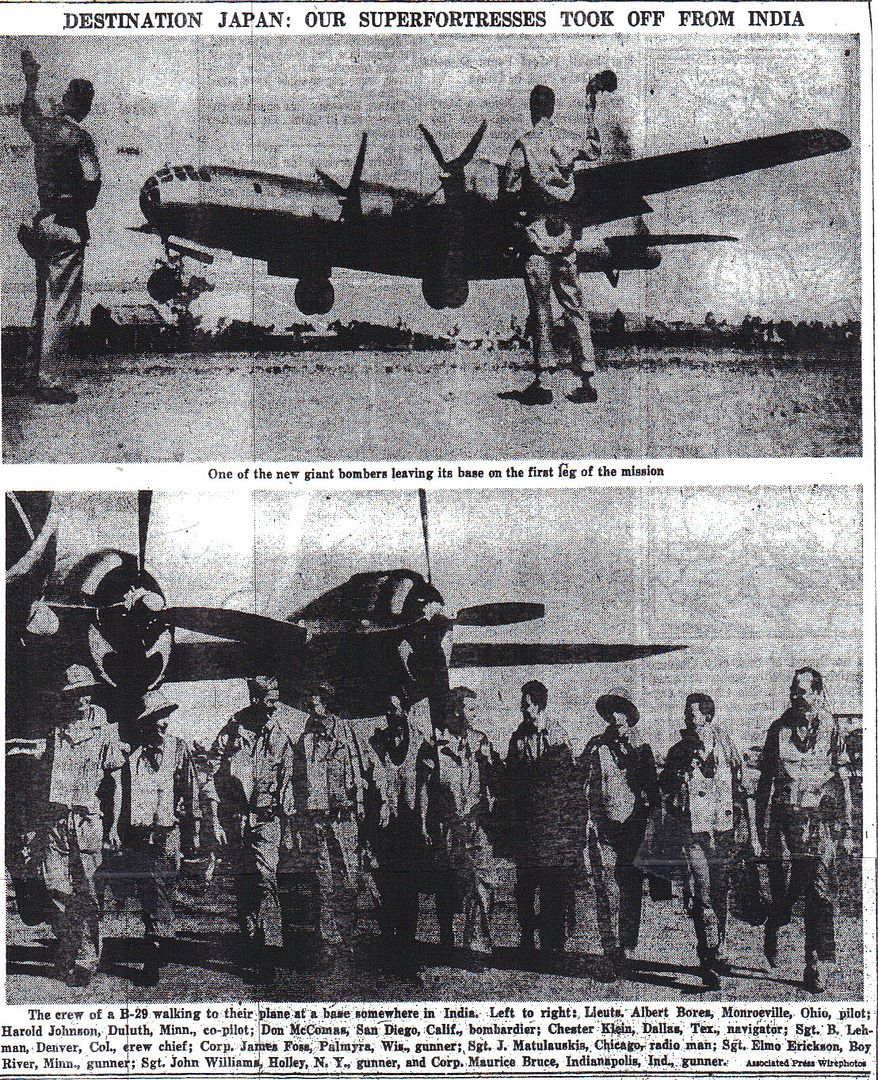
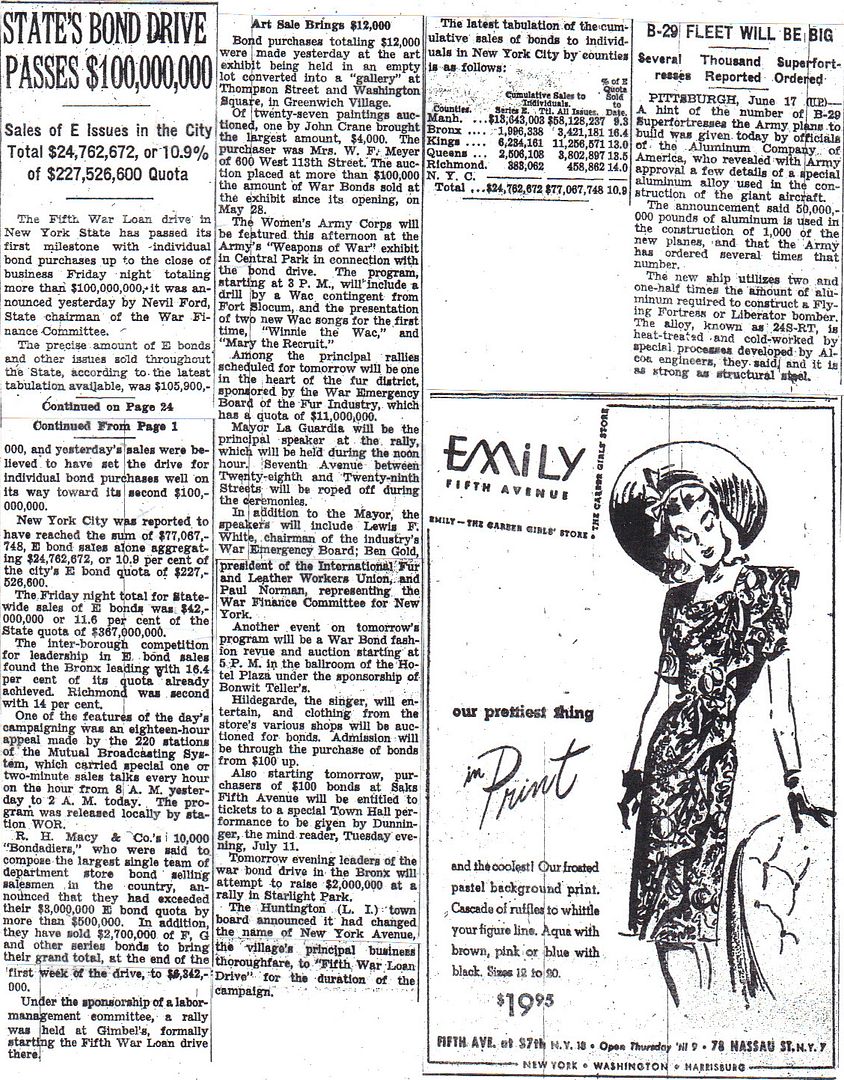
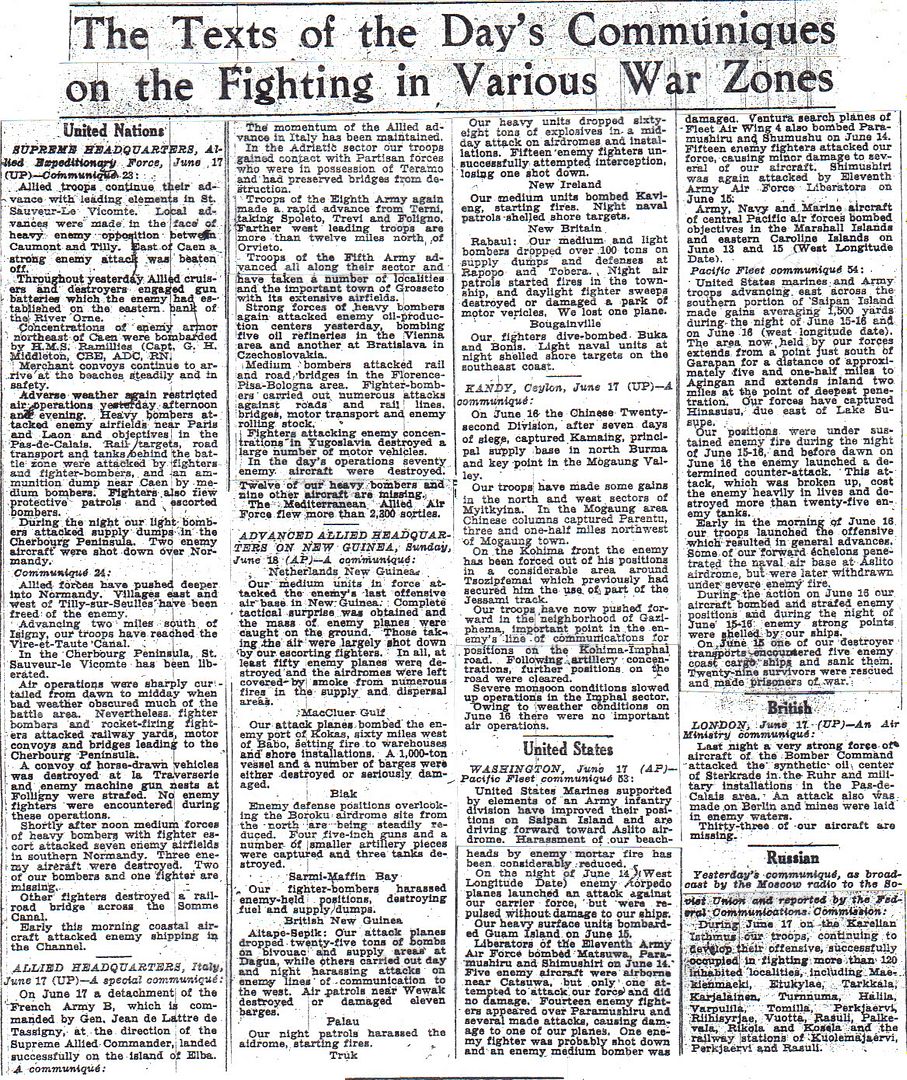
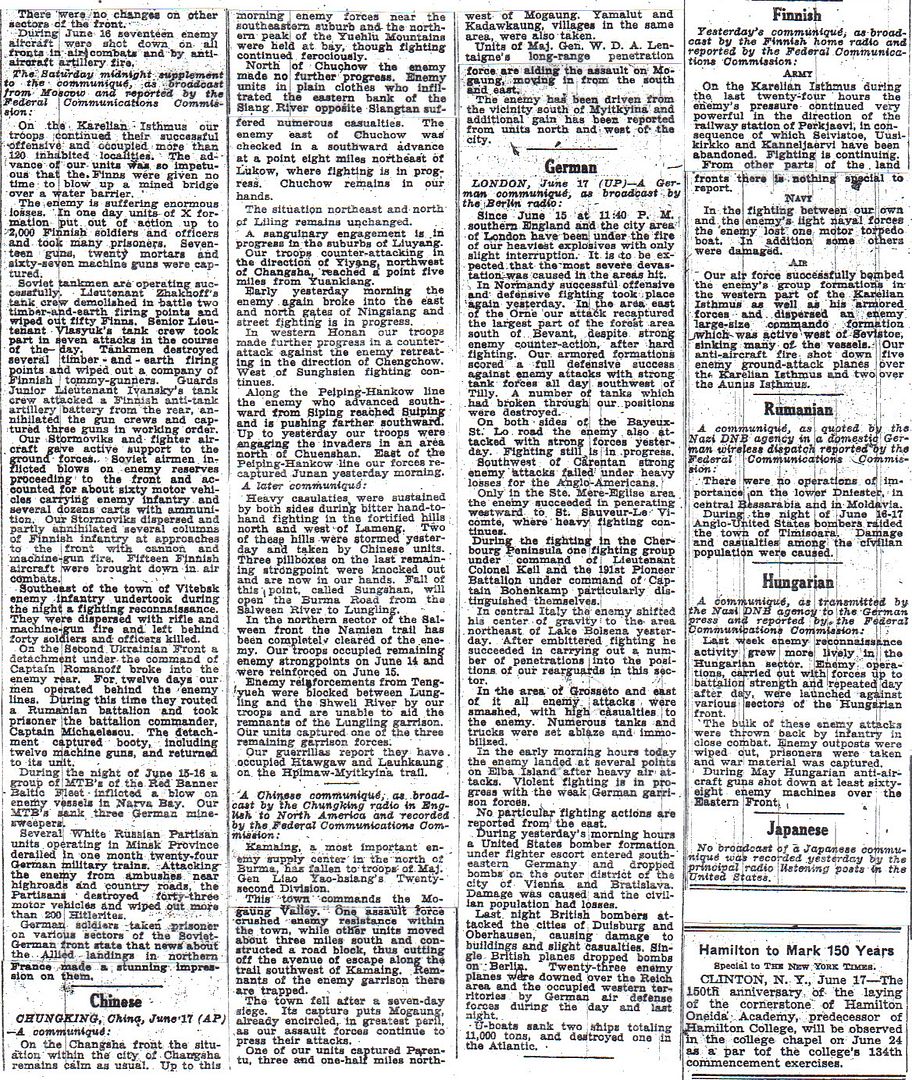
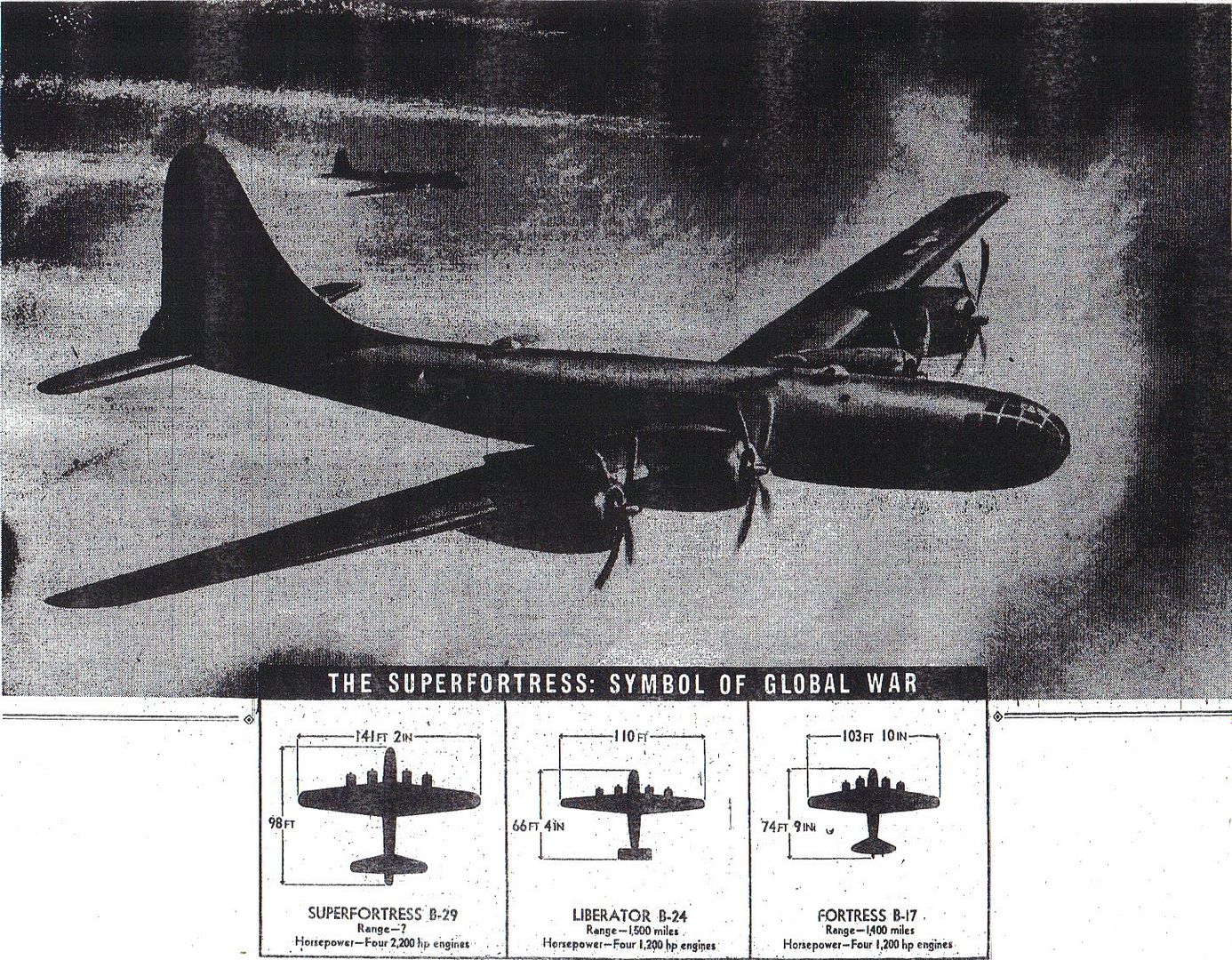

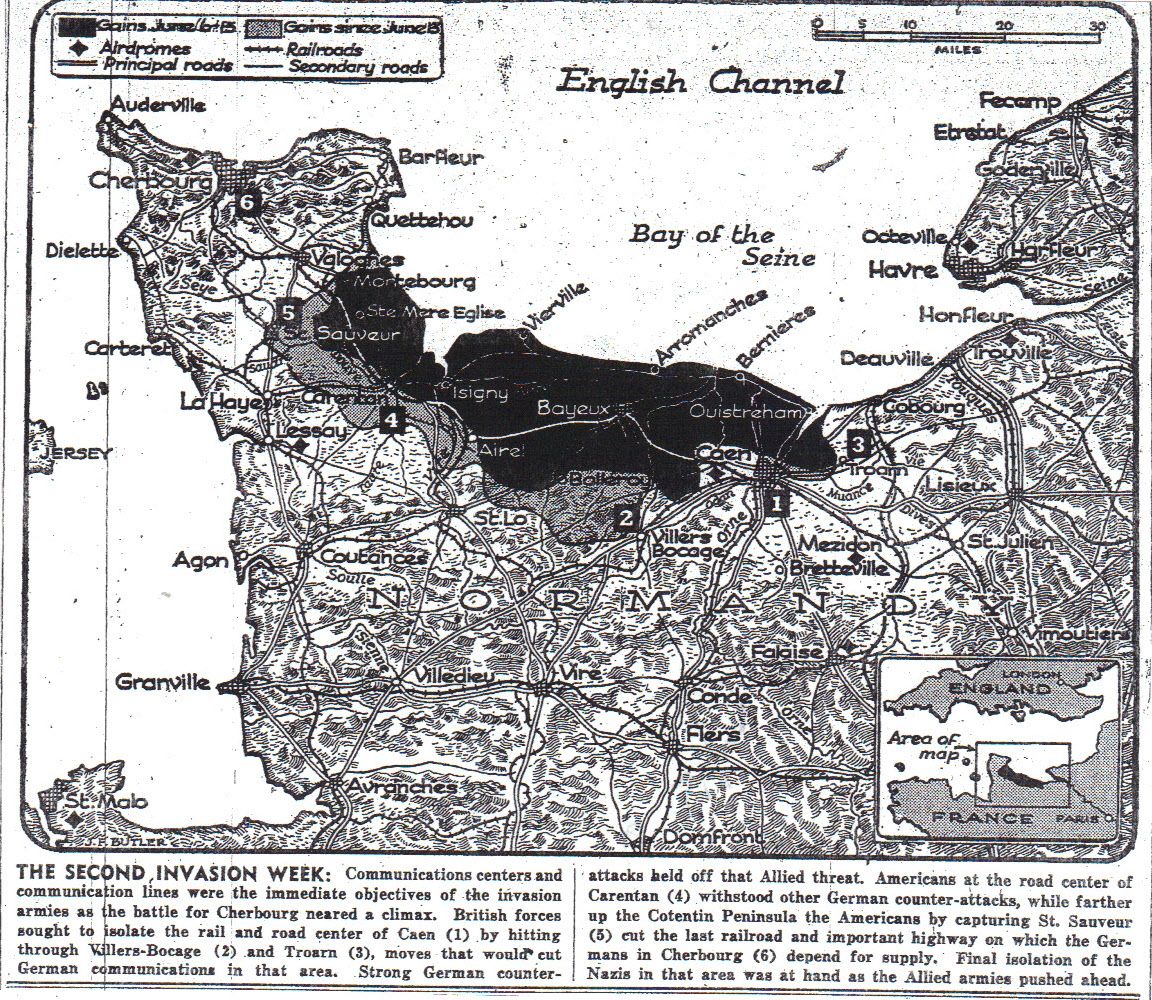
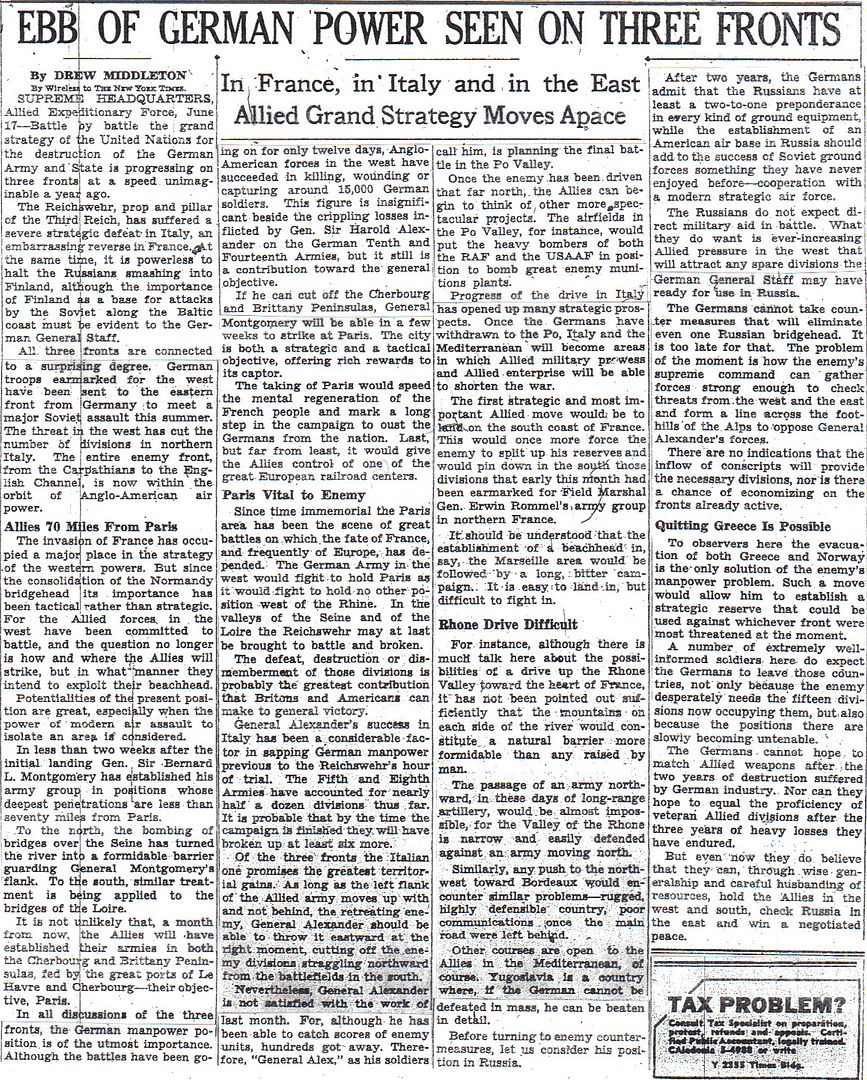
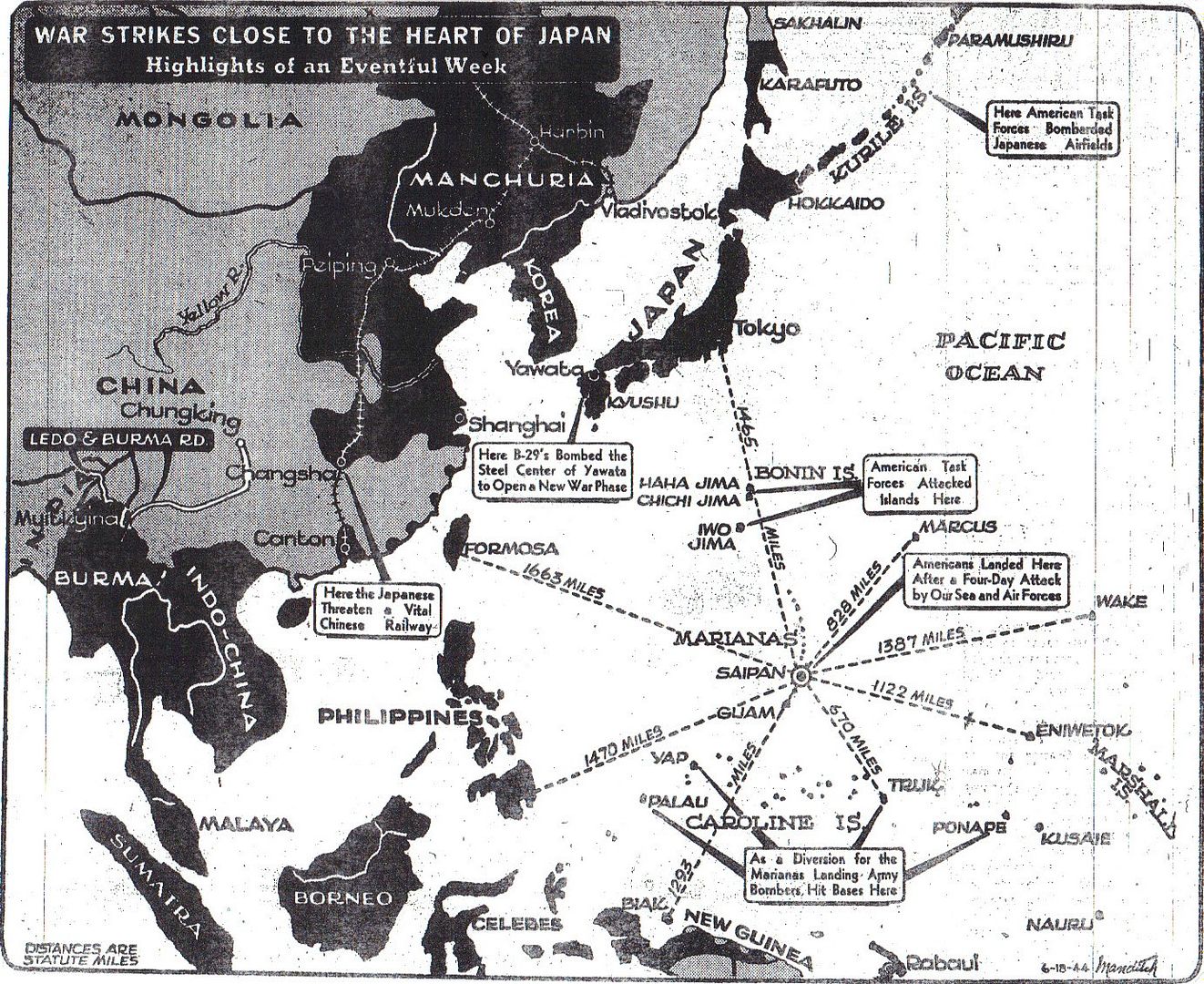
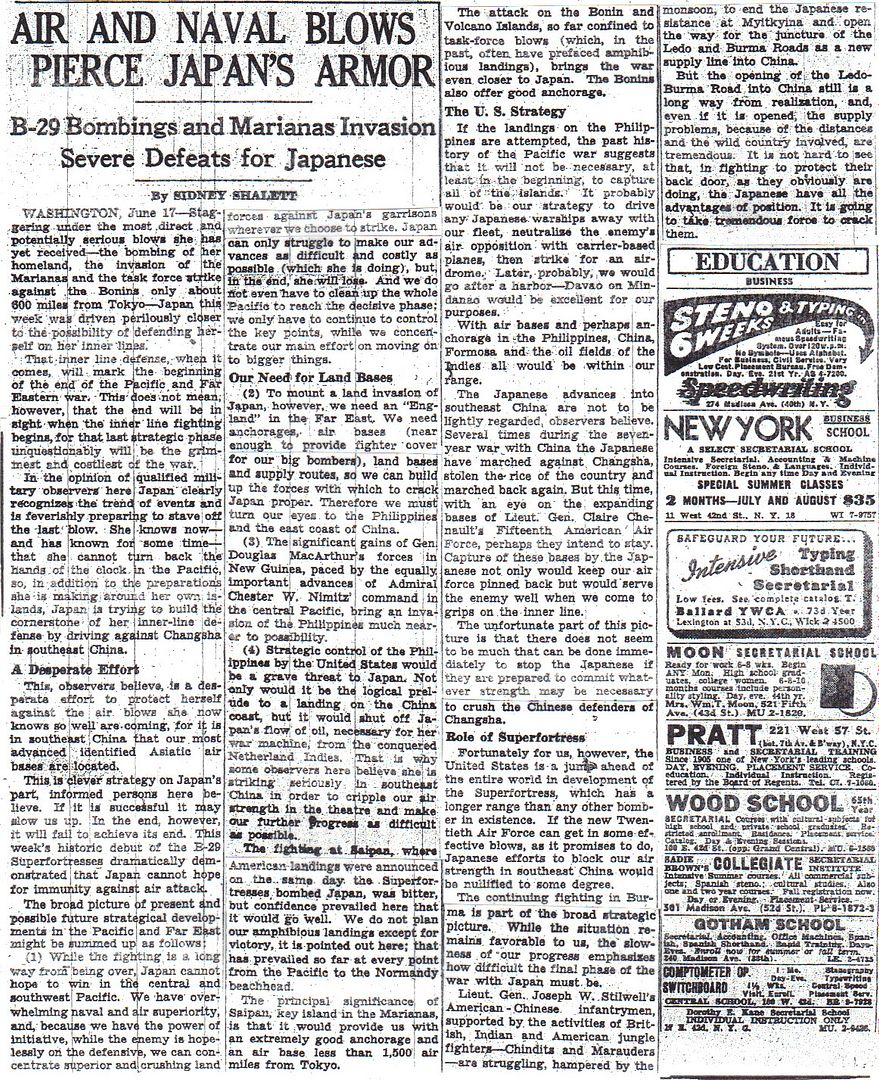
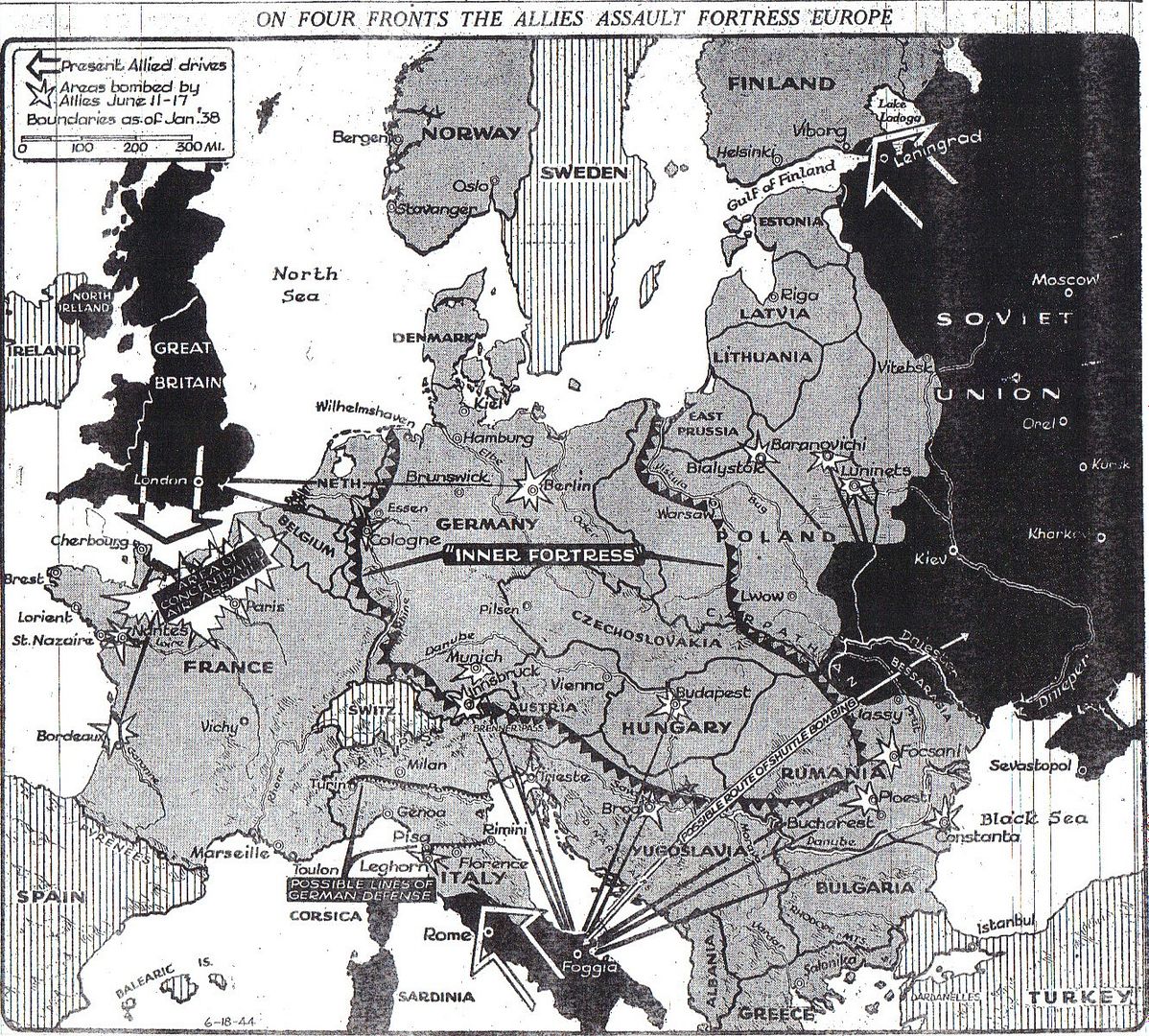
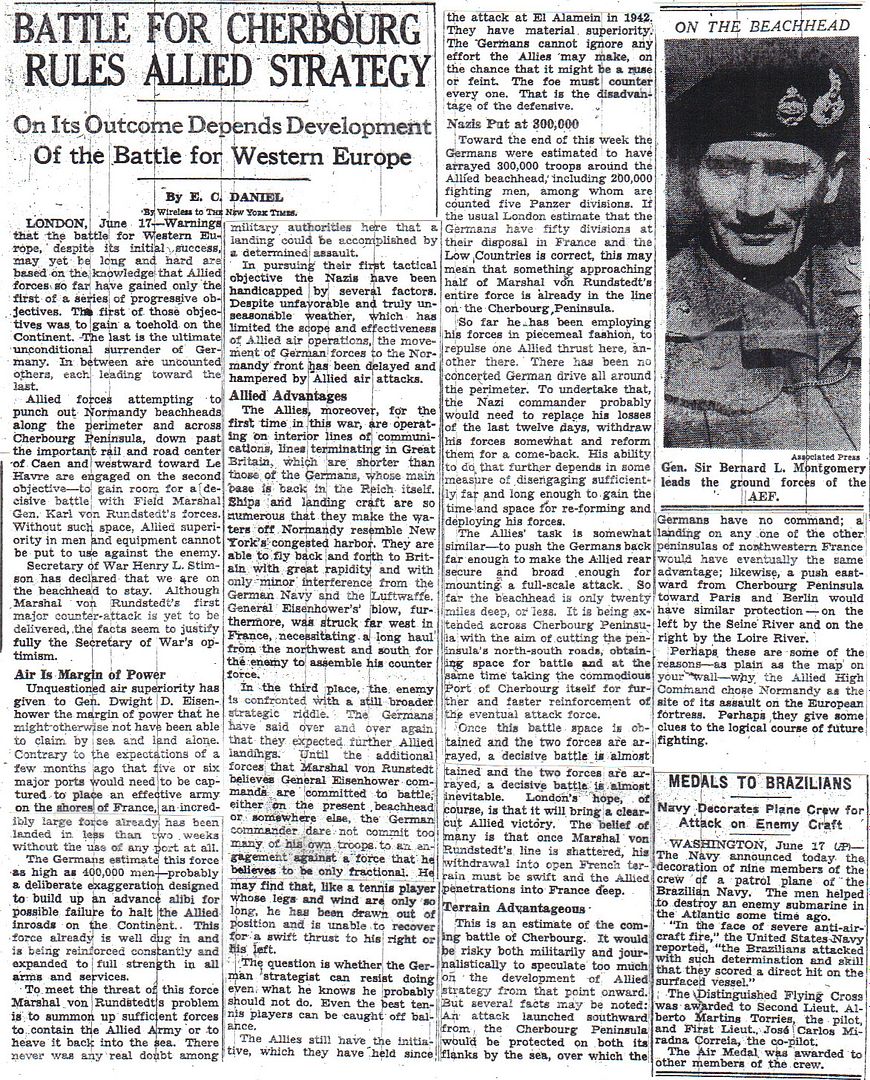
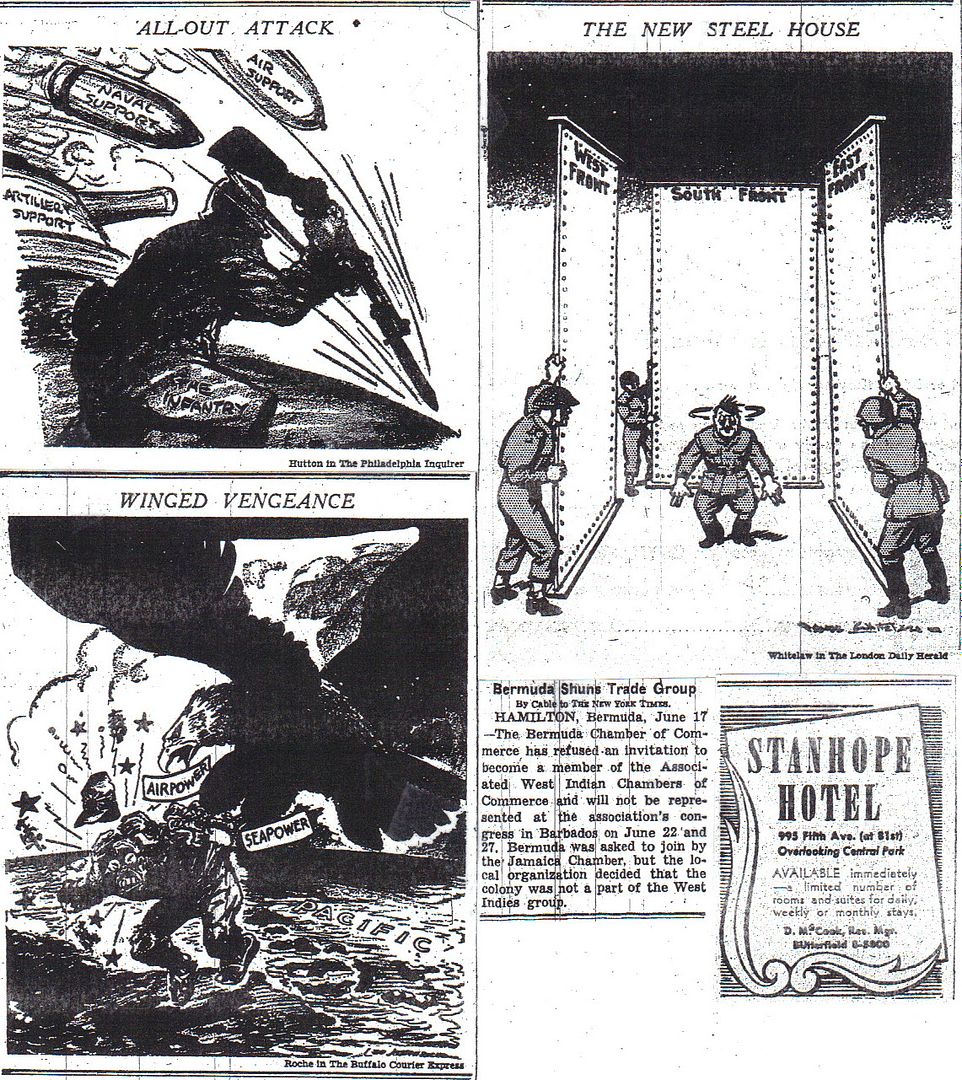
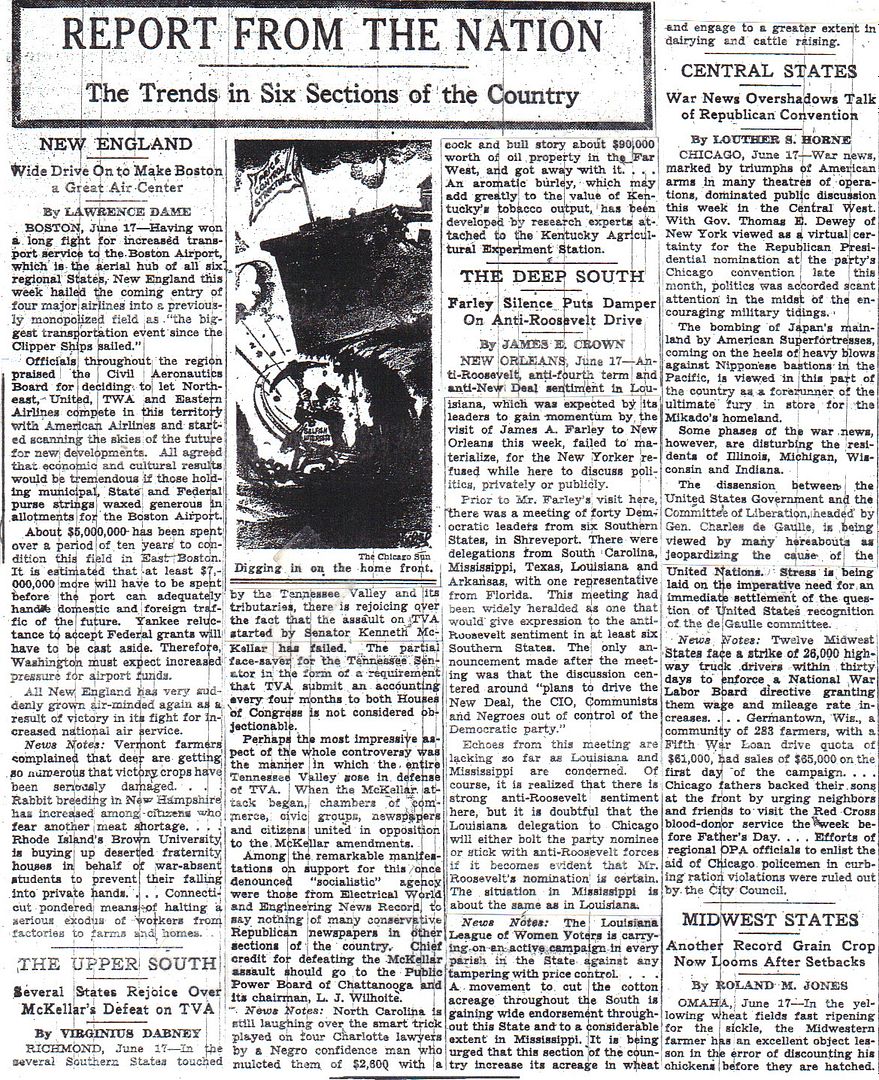
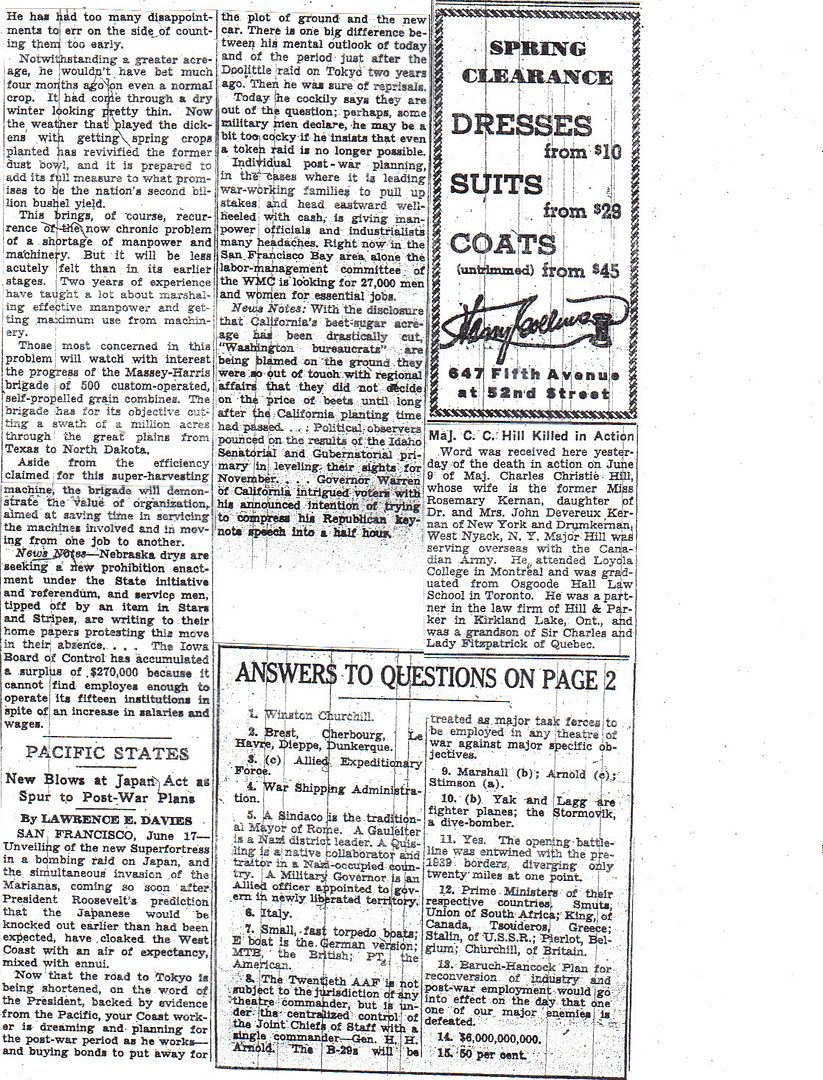
Ministers who wish to visit Normandy for any purpose should inform me of what they propose. I will then consult General Eisenhower’s wishes. No other visitors should be permitted to go, except with General Eisenhower’s concurrence.
2. This should be brought to the notice of all concerned.
Winston S. Churchill, Triumph and Tragedy
The News of the Week in Review
The Superfortress: Symbol of Global War (illustration) – 16
Fifteen News Questions – 17
The Second Invasion Week (map) – 18
Ebb of German Power Seen on Three Fronts (Middleton) – 19
War Strikes Close to the Heart of Japan (map) – 20
Air and Naval Blows Pierce Japan’s Armor (Shalett) – 21
On Four Fronts the Allies Assault Fortress Europe (map) – 22
Battle for Cherbourg Rules Allied Strategy (by E.C. Daniel) – 23
Editorial cartoons – 24
Report from the Nation (by Lawrence Dame, Virginius Dabney, James E. Crown, Louther S. Horne, Roland M. Jones, and Lawrence E. Davies) – 25-26
Answers to Fifteen News Questions – 26
* The Times is attempting to retroactively disguise the fact that the B-29’s flew from China. Durdin’s eyewitness account of the bombing mission to Japan yesterday was datelined Chungking.
http://www.onwar.com/chrono/1944/jun44/18jun44.htm#
US Marines advancing on Saipan
Sunday, June 18, 1944 www.onwar.com
In the Mariana Islands... On Saipan, elements of the US 5th Amphibious Corps continue to make progress. The 4th Marine Division reaches the west side of the island at Magicienne Bay. This advance divides the Japanese garrison. Elements of the 27th Division capture Aslito airfield. Japanese air strikes sink 1 American destroyers and 2 tankers as well as damaging the escort carrier Fanshaw Bay. Most of the American air and naval support has withdrawn to meet the approaching Japanese fleet.
In the Philippine Sea... The main US carrier forces rendezvous west of the Mariana Islands. Japanese scout planes sight the American fleet late in the day. The Japanese command intends to launch air strikes next morning, while still beyond range, and fly the aircraft to Guam to refuel and rearm.
In Italy... Elements of British 8th Army capture Assisi and continue to advance toward Perugia. Elements of the French Expeditionary Corps (part of US 5th Army), in the west, enter Radicofani.
On the Eastern Front... In the far north, Soviet forces of the Leningrad Front break through the Finnish defensive positions and advance toward Viipuri.
http://www.etherit.co.uk/month/thismonth/18.htm
June 18th, 1944 (SUNDAY)
UNITED KINGDOM: London: A flying bomb fell on the Guards Chapel at Wellington Barracks only yards from Buckingham Palace, during morning service today. The building was almost completely destroyed and 119 worshippers, half civilians, half servicemen, were killed. Another 102 were seriously injured. The V1s generally cause higher casualties than the usual aircraft bombing. Flying bombs come over from northern Europe in a steady stream, night and day, so no warnings can be given.
The USAAF’s Eighth Air Force in England flies two missions.
Mission 421: 1,378 bombers are dispatched to targets in Germany; eleven bombers are lost, ten to AA fire and one to unknown causes:
1. Of 890 B-17s dispatched, 381 bomb Hamburg, 88 hit Hannover-Misburg oil refinery, 85 hit the Bremen area; 60 hit Hannover, 54 hit Hamburg-Eurotank oil refinery, 38 hit Hamburg-Ossag oil refinery, 36 hit Hamburg-Schindler oil refinery, 18 hit Bremen-Oslebshausen; 18 hit Hamburg-Ebano oil refinery and five hit targets of opportunity; seven B-17s are lost.
2. Of 488 B-24s, 168 hit Hamburg, 107 bomb Bremerhaven, 58 attack the Watten V-weapon sites, France, 54 hit Brunsbuttel, 45 hit Stade Airfield, 28 hit Wesermunde, 13 hit Husum Airfield, nine hit Nordenham, eight hit Heligoland Airfield, five hit targets of opportunity and one hits Wrist marshalling yard; four B-24s are lost.
Escort is provided by 198 P-38s, 172 P-47 Thunderbolts and 215 P-51 Mustangs.
Other VIII Fighter Command missions in France are:
1. 94 of 98 P-38s and 82 of 87 P-47s attack railroad bridges in the St Quentin area without loss.
2. 47 P-51s make a sweep of the Dol de Bretagne area; three P-51s are lost).
Mission 422: Nine B-24s are dispatched on CARPETBAGGER missions in France; a B-24 hits a tree at the drop zone.
In France, the USAAF’s Ninth Air Force in England dispatches about 130 A-20 Havocs and B-26s to bomb fuel dumps at Foret d’Andaine and Conches and marshalling yards at Rennes and Meudon during the morning and NOBALL (V-weapon) targets in the afternoon; fighters, in addition to escort duty, continue strafing and bombing rail lines, troop concentrations, and highway traffic on the Cherbourg Peninsula.
ENGLISH CHANNEL: U-767 sunk in 230’ of water, depth charged, 1 trapped gets out with Drager gear from bottom without an air lock, PoW. (Mark Horan)
SS Albert C Field (1,764 GRT) Canadian Upper Lakes and St. Lawrence Transportation Co. bulk laker sunk by a torpedo in a dusk attack from a Luftwaffe JU-88 torpedo-bomber a/c, in the English Channel, position 50.28N, 001.46W. The ship was part of the twelve-ship Penarth, Wales, to Normandy beachhead convoy EBC-14. She was carrying a cargo of 2,500 tons of ammunition and 130 bags of US Army mail. The ship broke in half and sank quickly. Four crewmembers were lost from her 33 men. The British Western Isles-class armed trawler HMS HERSCHELL rescued the survivors. The rescue was greatly assisted by the small red lights and whistles that had only recently been added to the standard life vests then in use.
FRANCE: US First Army troops reach the west coast of the Cotentin Peninsula at Barneville. Cutting off the German-held port of Cherbourg.
POLAND: The Germans launch a six-day sweep against partisans near Lublin.
FINLAND: Soviet attacks breech the Finnish Main Defence Line and they advance towards Viipuri. The 4th Division and 3rd Brigade were repelling Soviet attacks in old positions in Summa, the famous battlefield of the Winter War. Leningrad Front’s successes against Finland are recognized by promotion of its commander Army General Leonid Govorov to Marshal of the Soviet Union, and commander of the 21st Army Lt. Gen. D. Gusev to Colonel General.
Six German AF barges are ordered to protect transports in Koivisto area. Securing patrol boat VMV 17 is destroyed by Soviet warplanes in Koivisto at Tiurinsaari Island. Six men lost.
ITALY: The Allies capture Assisi.
CHINA: Changsha: After two weeks of fierce fighting the 200,000-strong Japanese Eleventh Army has taken the central Chinese cities of Changsha and Chuchow. Its next target is Hengyang, 75 miles away, an important railway junction on the Canton to Hankow line. The three-week-old Japanese offensive is intended to capture key Chinese supply lines before advancing south and west to destroy Allied airfields in China. It is from these that the new long-range US B29s bombed the Japanese mainland three days ago.
MARIANAS ISLANDS, SAIPAN: The 4th Marine Division reaches the west side of Saipan at Magicienne Bay. The 27th Division captures Aslito Airfield.
PACIFIC OCEAN: Allied CINCPAC COMMUNIQUÉ NO. 55, In the early morning of June 17 (West Longitude date) the enemy launched an amphibious counterattack against our forces on Saipan. A group of troop-carrying barges attempted a landing south of Garapan, but were re-pulsed by our armed landing craft. (Denis Peck)
The Japanese Naval forces continue toward the Marianas. Towards evening they sight the US 5th Fleet.
In the opening moves of the Battle of the Philippine Sea, nine IJN land-based bombers, Navy Type 1 Attack Bomber, Allied Code Name “Betty,” are dispatched from their base in Yap Atoll to search for the U.S. fleet. The aircraft miss the ships of Task Force 58 but locate one of the Fifth Fleet escort carrier task groups. As a result of their sighting, the Japanese dispatch six land-based bombers, Kugisho P1Y Navy Bomber Ginga, Allied Code Name “Frances,” escorted by eleven Mitsubishi A6M Navy Type 0 Carrier Fighters, Allied Code Name “Zeke,” from Yap Atoll and 38 A6M “Zekes” and a Kugisho D4Y Navy Carrier Bomber Suisei, Allied Code Name “Judy,” from Palau Island. These aircraft fail to locate the escort aircraft carriers but at 1545 hours local, they sight and attack a group of fleet oilers east-northeast of Guam; two oilers are hit and a third is damaged by a near miss.
U.S.A.:
Submarines USS Chub and Lamprey launched.
Escort carrier USS Bouganville commissioned.
ATLANTIC OCEAN: Frigate HMCS Charlottetown arrived Bermuda for workups.
Don't take all this anti-robot talk personally, Bender.

Things were different back in the twentieth century.
What the he!! are those women doing in the Nemo Foundations ad????
Hard to wrap my mind around the activities in the Marianas of June 19 being posted on June 18 due to the International Date Line.
Anyway, today the Nimitz Diary has the report of Cavalla sinking a Shokaku Class carrier. It was in fact Shokaku that was attacked and sunk. There is a detailed analysis of the attack on Shokaku, as well as her damage and sinking found at:
http://www.combinedfleet.com/shoksink.htm
For anyone who wishes to see a detailed historical reconstruction, I highly recommend you take the time to read this analysis. Also, the account of damage, and sinking, is very well written.
This information comes from the “Combined Fleet” website, which is one of the finest online resources of the Pacific War out there. The level of detail and analysis done for this article was also done by the hosts of the Combined Fleet site in their book “Shattered Sword, the Untold Story of the Battle of Midway.” It’s probably the best work done on that battle.
All in good fun.
Personally, I never iron my elastic.
Thanks for the link. Very interesting story. The Shokaku sailors met a grisly end.
Thanks for the link. I read it all.
Ironing!
Don’t know why, but I have a hankering to go out and do some shooting. Maybe turkeys . . .
One of the concerns about bombing from China was the security situation and what would happen if the Japanese figure out where the bases were and began a land push that direction. Not of lot of confidence in the Chinese army to protect us.
What I like about Parshall and Tully is that they can provide such a detailed technical analysis based on the historical record, and also convey the sense of tragedy in human terms.
One of the other contributors to their website, Craig Burke, was someone I corresponded with when I was on The History Channel website. He was a great guy with a lot of knowledge about the Pacific War, but he lost a battle to prostate cancer last year.
By the way, one of the other contributors to the THC website, Pete Paradis, found about 5 volumes of the official U.S. Army History at a bookstore closing, and even though he lived on the other side of the country he was kind enough to ship them to me. That’s where I got the U.S. Army maps I posted last night.
The Army really did the right thing with it's thorough publications on the history of WWII. Some of the best historians in the country worked on that project.
I too had a hard time understanding such a thing.
The article was excellent. Thanks henkster.
Disclaimer: Opinions posted on Free Republic are those of the individual posters and do not necessarily represent the opinion of Free Republic or its management. All materials posted herein are protected by copyright law and the exemption for fair use of copyrighted works.